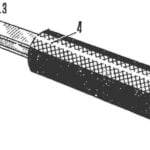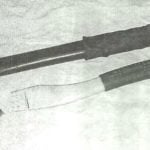 My good friend since high school, enthusiastically collected stamps, matchbox labels, pocket calendars. Now his collection continues to children, and himself, he left only one passion: icons. And store came up with the original book, which makes itself as their collection. Material for their production is either thin cardboard or even paper.
My good friend since high school, enthusiastically collected stamps, matchbox labels, pocket calendars. Now his collection continues to children, and himself, he left only one passion: icons. And store came up with the original book, which makes itself as their collection. Material for their production is either thin cardboard or even paper.
The basis of the book – box, which is formed from a single workpiece according to the pattern shown in figure 5 with the scale grid. It is sufficient to transfer a pattern of the desired size on a piece of cardboard, outline its contours, mark the cut and carefully cut with scissors: turn the workpiece, which remains to bend along the intended bend lines and can be folded to form the box body of the book. And without glue, thanks to the exclusively locking the connection of valves at the lower box part and the cover. And this is done in the following way.

Fig. 1. The main elements of the box-book (A box, B – plug-in sheathing):
1 – the front wall of the box;
2 – the sides of the box;
3 – side cover;
4 – locking tabs on the lid;
5 – slit side of the box
Once the bends at the marked lines, begins a kind of “Assembly” items box. First sides are joined by their counter-cut the valves, bent towards each other from front and rear walls of the box: get a locking connection. Now they can put overlap, bending through the entry valve, in fact the side flaps, thus forming the side walls of the box (see Fig.Z).

Fig. 2. Harvesting crates:
1 – short transverse strip (4 PCs.);
2-long longitudinal stripes (3 PCs.)

Fig. 3. The formation of the sidewall (right) box:
1 – bottom;
2 – the valve from the back wall;
3 – side panel;
4 – castle counter cutout valve;
5 – valve from the front wall;
6 back wall
Now from strips with opposing cutouts (see Fig.2) going to the wire mesh crate and inserted into the box. Ends of long strips of lathing pressed bent the sides of the box, thus providing a sustainable of their stiffness.

Fig. 4. Closure caps:
1 – side panel box;
2 – side panel lid;
3 -slit the sides of the box;
4 – castle petal lid;
5 – the front wall of the box
In cells crates stacked badges or other collectable items and the box closes. With the sidewalls of the cover included inside the box, and the petals of the front wall of the cover are inserted into the slits bent the sides of the box (Fig. 4), forming a kind of castle, holding the lid in the closed state.

Fig. 5. Pattern book (grid – in the right size)
Bent even of paper, this box the book has sufficient rigidity and strength and easy to use.
B. RAWSKI


